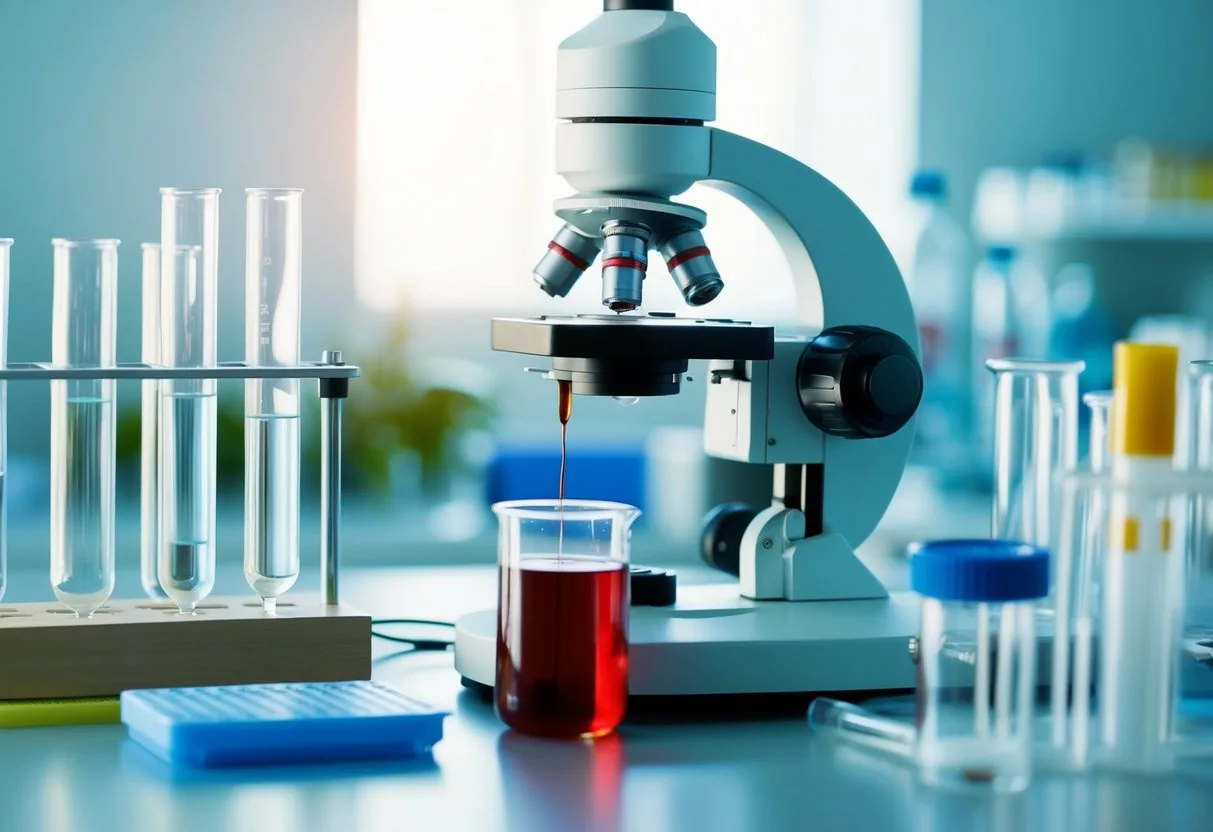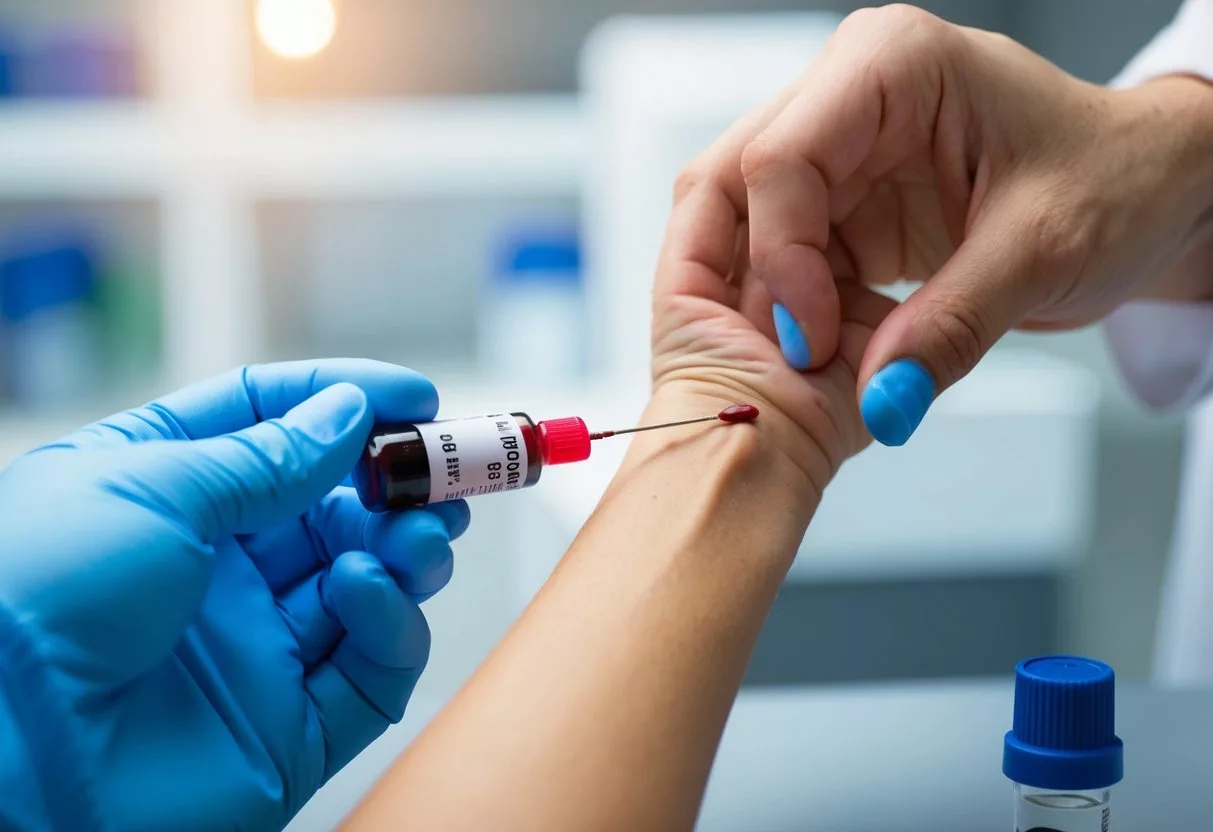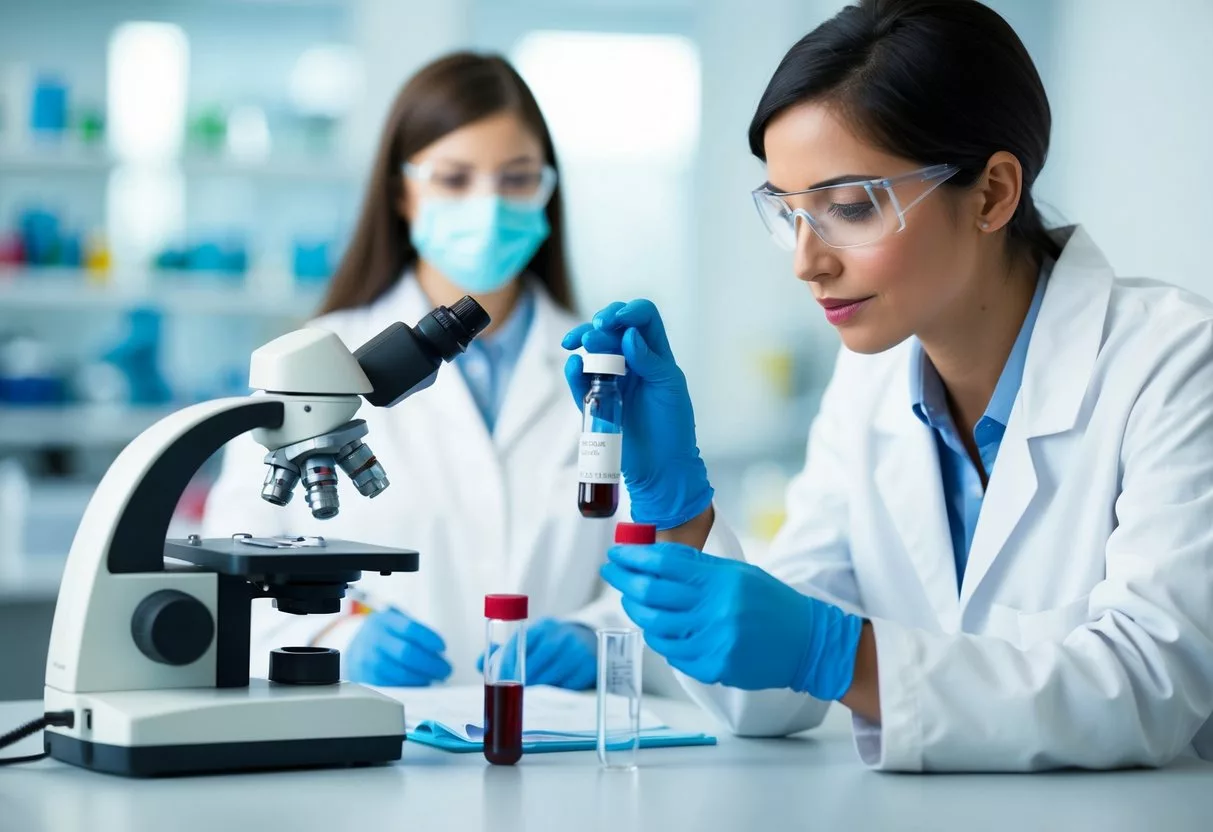Low estradiol levels in the blood can affect your health in many ways. Estradiol is a key form of estrogen that impacts various body systems. Women with low estradiol may experience symptoms like hot flashes, mood changes, and bone density loss.

Low estradiol can occur due to many factors, including menopause, certain medical conditions, or medications. It’s important to understand the signs of low estradiol to seek proper care. Symptoms of low estradiol may include irregular periods, vaginal dryness, and trouble sleeping.
If you suspect low estradiol, talk to a doctor. They can do a simple blood test to check your levels. Treatment options exist to help manage symptoms and protect your health.
Key Takeaways
- Low estradiol can cause various symptoms and health issues in women
- A blood test can diagnose low estradiol levels
- Treatment options are available to manage low estradiol and its effects
Understanding Estrogen and Its Role in the Body

Estrogen is a key hormone in the female body. It affects many parts of health and growth. The body makes different types of estrogen that each have special jobs.
The Different Forms of Estrogen
There are three main types of estrogen in women:
- Estradiol: The strongest form, most common in women who can have babies
- Estrone: The main type after menopause
- Estriol: Most present during pregnancy
Estradiol is the most powerful of these. The ovaries make most of the estrogen. Small amounts also come from fat cells and adrenal glands.
Estradiol’s Importance in Women’s Health
Estradiol plays a big role in women’s health. It helps with:
- Sexual growth during puberty
- Bone strength
- Heart health
- Brain function
Low estradiol can cause problems. It may lead to weak bones, heart issues, and mood changes. Estrogen helps protect the heart in women before menopause.
How Hormone Levels Are Regulated
The body controls hormone levels carefully. This process involves:
- The brain (hypothalamus and pituitary gland)
- Ovaries
- Feedback loops
These parts work together to keep hormone levels steady. During the menstrual cycle, estrogen levels change. They are highest just before ovulation.
Too much or too little estrogen can cause health issues. The body tries to keep a good balance. Sometimes hormone therapy is used to fix imbalances.
Causes of Low Estradiol Levels

Low estradiol levels can stem from various factors related to hormonal changes and health conditions. These causes can impact estrogen production and lead to symptoms associated with low estrogen.
Menopause and Perimenopause
Menopause is a natural process that marks the end of a woman’s reproductive years. During this time, estradiol levels drop significantly.
Perimenopause, the transition period before menopause, can last several years. In this phase, estrogen levels start to fluctuate and gradually decline.
As ovaries produce less estrogen, women may experience symptoms like hot flashes, night sweats, and vaginal dryness.
Premature Ovarian Failure
Primary ovarian insufficiency, also known as premature ovarian failure, occurs when ovaries stop functioning before age 40. This condition causes estrogen levels to drop earlier than expected.
Women with this condition may experience:
- Irregular or missed periods
- Difficulty getting pregnant
- Symptoms similar to menopause
Genetic factors, autoimmune disorders, or certain medical treatments can contribute to premature ovarian failure.
Factors Affecting Estrogen Production
Several factors can influence estrogen production in the body:
- Eating disorders may lead to low body fat, affecting hormone production.
- Excessive exercise can disrupt the menstrual cycle and hormone balance.
- Certain medications, like aromatase inhibitors used in breast cancer treatment, can lower estrogen levels.
- Stress can impact the endocrine system, potentially affecting estrogen production.
Hormonal imbalances involving luteinizing hormone (LH) can also play a role in low estradiol levels.
Cholesterol serves as a precursor for estrogen production. Issues with cholesterol metabolism may affect estrogen synthesis.
Signs and Symptoms of Low Estrogen

Low estrogen can cause various symptoms that affect physical and mental health. These symptoms can impact menstrual cycles, body temperature regulation, and cognitive function.
Effects on Menstrual Health
Low estrogen levels can disrupt normal menstrual patterns. Women may experience irregular or missed periods. The menstrual flow might become lighter or heavier than usual.
In some cases, periods may stop completely, a condition known as amenorrhea. This can make it harder to get pregnant.
Low estrogen can also lead to vaginal dryness and discomfort during intercourse. The vaginal walls may become thinner and more prone to irritation.
Vasomotor Symptoms
Vasomotor symptoms are common in women with low estrogen. These include:
- Hot flashes: Sudden feelings of heat in the upper body, face, and neck
- Night sweats: Hot flashes that occur during sleep
- Chills: Often following hot flashes
These symptoms can disrupt daily activities and sleep patterns. They may vary in intensity and frequency among different women.
Psychological and Cognitive Impact
Low estrogen levels can affect mental health and cognitive function. Women may experience:
- Mood swings and irritability
- Increased risk of depression and anxiety
- Difficulty concentrating or “brain fog”
- Memory problems
These cognitive changes can impact work performance and daily tasks. Some women report feeling less sharp or focused.
Low estrogen may also affect sleep quality, leading to fatigue and further impacting mood and cognitive function.
Health Consequences of Low Estradiol

Low estradiol levels can have wide-ranging effects on the body. These impacts primarily affect bone health, heart function, and skin and hair condition.
Bone Health and Osteoporosis Risk
Low estradiol increases the risk of osteoporosis. This condition weakens bones, making them fragile and more likely to break. Estradiol helps maintain bone density by slowing bone breakdown.
When levels drop, bone loss speeds up. This can lead to a higher chance of fractures, especially in the hip, spine, and wrist. Regular bone density scans can track changes over time.
Weight-bearing exercises and calcium-rich foods help support bone health. Vitamin D is also important for calcium absorption. Some people may need medication to slow bone loss and reduce fracture risk.
Cardiovascular Health Concerns
Estradiol protects heart health in several ways. It helps keep blood vessels flexible and promotes healthy cholesterol levels. When estradiol drops, these benefits decline.
Low levels can lead to:
- Stiff arteries
- Higher bad cholesterol (LDL)
- Lower good cholesterol (HDL)
- Increased risk of heart disease and stroke
Regular exercise, a heart-healthy diet, and not smoking can help protect cardiovascular health. Some people may need medication to manage cholesterol or blood pressure.
Effects on Skin and Hair
Estradiol plays a key role in skin health and hair growth. Low levels can cause noticeable changes.
Skin effects:
- Thinning and loss of elasticity
- Dryness and itching
- Slower wound healing
Hair changes:
- Thinning or loss, especially on the scalp
- Slower growth
- Increased facial hair in some cases
Moisturizers and gentle skin care can help manage dryness. For hair loss, treatments like minoxidil may be helpful. A balanced diet rich in vitamins and minerals supports both skin and hair health.
Diagnosis and Monitoring

Doctors use blood tests to check estradiol levels. They look at hormone levels and symptoms to figure out if estradiol is low. Test results help guide treatment plans.
Blood Tests and Hormone Levels
Blood tests measure estradiol in the body. A small sample of blood is taken from a vein. The sample goes to a lab for testing. Doctors may also check other hormones like luteinizing hormone (LH).
LH levels can give clues about estradiol function. High LH may mean low estradiol. Some clinics use urine tests to track hormones over time. This can show patterns in hormone balance.
Blood tests are quick and usually don’t hurt much. Results often come back in a few days. Doctors may order tests at different times of the month for women who still have periods.
Understanding Test Results
Test results show estradiol levels in picograms per milliliter (pg/mL). Normal ranges differ based on age and gender. For women, levels change during the menstrual cycle.
Low estradiol can cause various symptoms. These may include hot flashes, mood changes, and bone loss. Not everyone with low levels has symptoms.
Doctors look at test results and symptoms together. They use this info to make a diagnosis. Sometimes more tests are needed. Treatment depends on the cause of low estradiol and how bad symptoms are.
It’s key to talk with a doctor about test results. They can explain what the numbers mean for each person’s health.
Treatment Options for Low Estradiol

Low estradiol levels can be treated through various approaches. These include hormone therapy, non-hormonal treatments, and lifestyle changes. Each option aims to address symptoms and improve overall well-being.
Hormone Replacement Therapy
Hormone replacement therapy (HRT) is a common treatment for low estradiol. It involves taking estrogen to bring levels back to normal. HRT can help with many symptoms like hot flashes and vaginal dryness.
There are different ways to take HRT. Pills, patches, gels, and creams are some options. The right choice depends on a person’s needs and health history.
HRT can improve sexual function and boost libido. It also helps maintain bone health and may prevent weight gain. But it’s important to know about possible side effects. These can include bloating, breast tenderness, and nausea.
Non-Hormonal Interventions
For those who can’t or don’t want to use HRT, there are other options. These treatments focus on specific symptoms of low estradiol.
Vaginal moisturizers and lubricants can help with vaginal dryness and atrophy. They improve comfort during sex and daily life.
Some women find relief from hot flashes with certain medications. These include some antidepressants and anti-seizure drugs. They work by affecting brain chemicals linked to body temperature.
Natural remedies like black cohosh or soy products may help some women. But their effects aren’t as strong or well-studied as HRT.
Lifestyle and Dietary Adjustments
Simple changes in daily life can help manage low estradiol symptoms. These changes support overall health and may ease some discomfort.
Diet plays a key role. Eating foods rich in phytoestrogens might help. These include soy products, flaxseeds, and certain fruits and vegetables.
Regular exercise is crucial. It can improve mood, sleep, and bone health. Weight-bearing exercises are especially good for bones.
Stress reduction techniques like yoga or meditation can help with mood swings. Getting enough sleep is also important for managing symptoms.
Avoiding triggers like caffeine, alcohol, and spicy foods can reduce hot flashes. Dressing in layers helps manage sudden temperature changes.
Impact on Sexual and Reproductive Health

Low estradiol levels can significantly affect a woman’s sexual and reproductive health. These effects can range from changes in libido to challenges with fertility.
Libido and Sexual Function
Low estradiol can lead to a decrease in sexual desire and arousal. Women may experience a reduced interest in sex or difficulty becoming aroused.
Vaginal dryness is another common issue. This can make intercourse uncomfortable or painful. Some women might also notice a thinning of the vaginal walls.
Lubrication during sexual activity may be reduced. This can further contribute to discomfort during sex.
Reproductive Health Considerations
Low estradiol levels can impact a woman’s menstrual cycle and fertility. Irregular periods or the absence of menstruation may occur.
Ovulation might be affected, making it harder to conceive. This can lead to fertility problems for women trying to get pregnant.
The uterine lining may not thicken properly. This can make it difficult for a fertilized egg to implant.
Bone health can also be impacted. Low estradiol may lead to decreased bone density, increasing the risk of osteoporosis.
Prevention and Management

Taking proactive steps can help maintain healthy estradiol levels. Regular medical check-ups play a key role in early detection and management of hormone imbalances.
Lifestyle Measures for Hormone Balance
A balanced diet rich in phytoestrogens can support estradiol production. These plant-based compounds are found in soy products, flaxseeds, and certain fruits and vegetables. Regular exercise also helps regulate hormones and improve overall health.
Stress management is crucial. High stress levels can disrupt hormone balance. Practices like yoga, meditation, or deep breathing exercises can help reduce stress.
Limiting alcohol and quitting smoking can positively impact estradiol levels. Both habits can interfere with hormone production and metabolism.
Maintaining a healthy weight is important. Excess body fat can lead to higher estrogen levels, while very low body fat can cause estradiol deficiency.
Benefits of Regular Health Check-ups
Regular check-ups allow for early detection of hormone imbalances. Blood tests can measure estradiol levels accurately, helping identify issues before symptoms become severe.
Health professionals can monitor bone density during check-ups. This is crucial as low estradiol can lead to bone loss.
Regular exams help track changes in sexual function and menopause symptoms. Healthcare providers can offer tailored advice and treatments based on individual needs.
Check-ups also provide opportunities to discuss vasomotor symptoms like hot flashes and night sweats. These can be signs of changing estradiol levels.
Frequently Asked Questions

Low estrogen levels can impact women’s health in various ways. The symptoms, causes, and treatments depend on factors like age and individual physiology.
What are common symptoms associated with low estrogen levels?
Low estrogen can cause several symptoms. These include dry skin, tender breasts, and weak bones. Women may also experience trouble concentrating and mood changes.
Other signs are hot flashes and night sweats. Vaginal dryness and painful intercourse can occur too.
How does age affect normal estradiol levels in the blood?
Estradiol levels change throughout a woman’s life. They are highest during reproductive years and decline with age.
During menopause, estradiol levels fall significantly. This drop leads to the end of menstruation and can cause various symptoms.
What are potential causes for low estrogen in women in their 30s?
Low estrogen in younger women can have several causes. Excessive exercise is one possible reason. Thyroid problems or autoimmune conditions may also lead to low estrogen.
Other factors include eating disorders, extreme stress, or certain medications. Sometimes, the cause is unknown.
How is low estrogen typically treated in younger women?
Treatment depends on the underlying cause. Hormone replacement therapy is often used to boost estrogen levels.
Lifestyle changes may help in some cases. These can include reducing exercise intensity or gaining weight if needed.
What could be the implications of low estrogen on a woman’s weight?
Low estrogen can affect body weight and composition. Some women may experience weight gain, especially around the waist.
Others might have difficulty maintaining weight due to changes in metabolism. Muscle mass can also decrease with low estrogen.
What are the body’s physiological changes when estrogen levels fall significantly?
When estrogen drops, it affects multiple body systems. The cardiovascular system may see changes in heart and blood vessel function.
Bone density often decreases, raising the risk of osteoporosis. Skin may become thinner and less elastic.